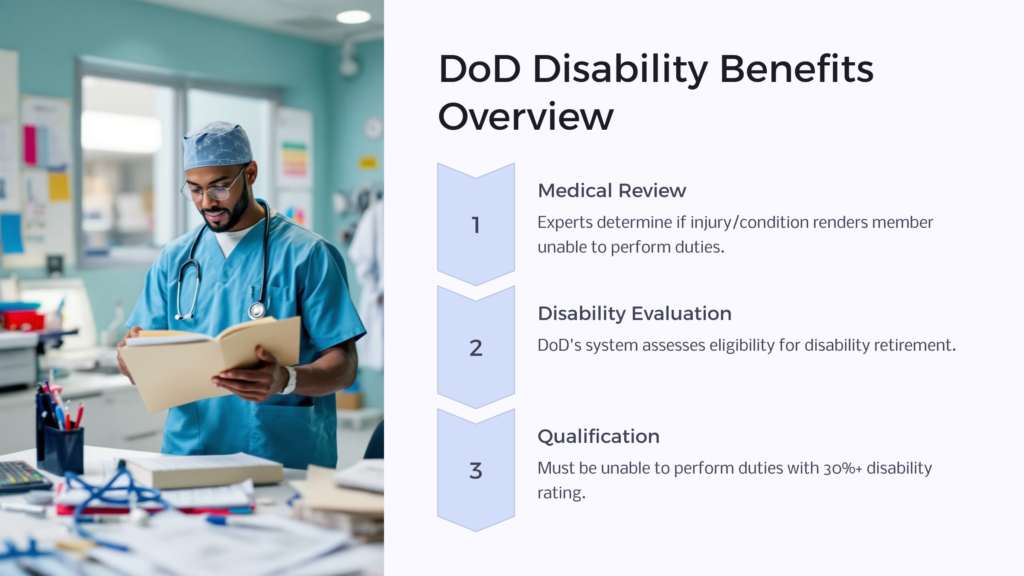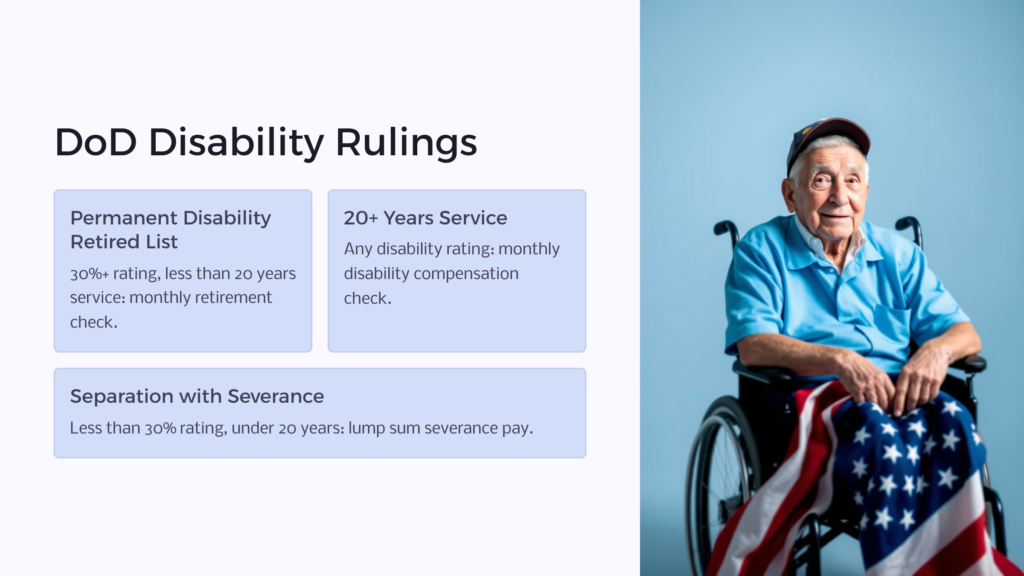If you’re a former member of the American armed services with a disability, you may be eligible for either U.S. Department of Veterans Affairs disability compensation benefits or disability compensation benefits from the U.S. Department of Defense. While both programs are designed to provide support for eligible military veterans, there are a few differences in the way the programs are administered that might make one program more fitting for your situation. While claiming the benefits you’re eligible for feels like a big puzzle, understanding these key differences can help you put all the pieces together.
4 Differences Between VA Disability and DoD Disability
- Duration of ratings
- Calculation of benefits
- Evaluation of medical conditions
- Length and complexity of the process

The U.S. government offers two separate and distinct pathways for disabled veterans to qualify for military disability benefits. Administered separately by the U.S. Department of Defense and the U.S. Department of Veterans Affairs, the two processes differ in how they assign ratings, calculate disability compensation benefits, evaluate medical conditions, and more.
The overall guiding philosophies of the two programs are markedly different. The DoD benefit program exists primarily to compensate servicemembers for the loss of income associated with their military service being cut short. In contrast, the VA disability compensation program is designed to compensate military members for the loss of civilian income after service.
If you think you might qualify for either of these benefits types, we’ll help you understand the key differences so you can choose the process that’s best for your particular injury or condition.
What Are DoD Disability Benefits?

Military disability retirement usually comes about as the result of a medical review – at any stage in a service member’s career, a team of medical experts may determine that an injury or health condition renders someone eligible for disability retirement. This means that the military has determined that an injury or medical condition makes someone able to perform their job duties.
Any time a member of the armed forces is injured or develops a health condition while serving, the DoD’s first priority is to provide appropriate medical treatment to get that servicemember back to active duty. During that time of treatment, the patient also may be evaluated according to the DoD’s Disability Evaluation System. Sometimes the results of the evaluation reveal that the military member should separate from service, in which case, he or she may be eligible for DoD disability compensation benefits.
To qualify for DoD disability benefits, you must be pronounced unable to perform your military duties and have a disability rating of at least 30% from the military. There is no application process for DoD military disability benefits – if a military doctor thinks your disability qualifies you, she will automatically refer you to the Medical Examination Board for disability consideration.

There are several different rulings the board can make:
- If you have less than 20 years of service and a disability rated at 30% or more, you will be placed on the Permanent Disability Retired List. At this point, you will receive a monthly retirement check, just as if you had retired after 20 years of service.
- If you have more than 20 years of service and a disability rated at any level, you are also placed on the PDRL and will receive a monthly disability compensation check.
- If you have less than 20 years of service and a permanent disability rated at less than 30%, you will be separated from service with severance pay. Severance pay is typically paid as a lump sum and is calculated as two times your rate of pay multiplied by your years of service.
- The board may also find you physically fit and determine that you should return to service.
4 Differences Between VA Disability and DoD Disability
There are four key ways that VA disability and DoD disability processes and compensation benefits are different.
1. Duration of Ratings
While VA disability ratings can be updated over time, DoD ratings are permanent. If the DoD rates your disability at a 25% benefit and places you on its Permanent Disability Ratings List, your condition will remain at a 25% rating for the remainder of your life. The DoD’s rating system is based on whether the injury or medical condition in question prevents you from effectively being able to carry out your military duties.
On the other hand, if your VA disability rating starts at 25%, the VA can adjust that later in your life if your condition improves or worsens. This means that your benefit amount can either increase or decrease, depending on changes to your condition.
2. Calculation of Benefits

The two military disability programs also calculate your benefit amount a little differently. For DoD disability benefits, your disability rating, your length of service, and your rank are taken into consideration when determining if you are an eligible veteran.
VA disability benefits, on the other hand, consider only the severity of the injury or condition in question. For VA disability compensation benefits, you must receive at least a 30% disability rating – between 30% to 50% will qualify you for health care with military disability retirement benefits. However, to be considered the highest priority for VA health care, you must receive a rating of 50% or higher.
3. Evaluation of Medical Conditions
When evaluating your disability claim, the DoD will provide a disability rating only for any condition that results directly from the injury that’s being claimed. The VA, however, looks at medical conditions more holistically when evaluating common VA disability claims. For example, if a member of the armed forces has suffered several injuries, but only one is related to the disability claim, the DoD will consider only that one injury when rating the disability for compensation benefits. The VA, on the other hand, will consider all the service member’s injuries when assigning its disability rating.
4. Length and Complexity of Process
The VA and the DoD have distinct processes for evaluating your disability claim. They can both be laborious and complex, and are influenced by the following factors:
- The nature of the injury or condition in your disability claim
- The amount and quality of medical evidence submitted in support of your disability claim
- The current backlog of cases
- The number of times your disability claim is denied and subsequently appealed
At one point, the VA reported that it took an average of 196 days to release an initial decision on a VA disability claim. The DoD process may stretch even longer because the DoD will first place someone on the Temporary Disability Rating List while their claim is being reviewed, especially if the medical examining board has reason to believe the condition could improve.
Military disabilities like asthma, nerve damage, back and neck injuries, mental disorders, and migraines are often seen on the TDRL. It’s possible for some applicants to remain on that temporary list for as long as five years, during which time they will receive a monthly stipend, plus medical coverage for the patient and dependent(s) until a medical condition can be corrected or at least stabilized. Considering this, it’s likely that the VA process will yield you a faster decision – but keep in mind that once your disability claim is approved, both the DoD and the VA will compensate you through back pay for the entire time since you incurred your injury.
Which Disability Benefits Should I Choose?
 If you don’t qualify for Concurrent Retirement and Disability Pay, then you’ll have to choose whether you’d rather receive VA or DoD benefits. That means you’ll have to waive either your disability retirement pay from the military or your disability benefits from the VA. This decision ultimately depends on the details of your situation – choose the option that best fits your medical situation and offers you the most benefit. For most claimants, it makes financial sense to waive the DoD benefits in favor of VA disability compensation. VA disability benefits aren’t taxed, which affords you a distinct advantage since DoD benefits are taxable income.
If you don’t qualify for Concurrent Retirement and Disability Pay, then you’ll have to choose whether you’d rather receive VA or DoD benefits. That means you’ll have to waive either your disability retirement pay from the military or your disability benefits from the VA. This decision ultimately depends on the details of your situation – choose the option that best fits your medical situation and offers you the most benefit. For most claimants, it makes financial sense to waive the DoD benefits in favor of VA disability compensation. VA disability benefits aren’t taxed, which affords you a distinct advantage since DoD benefits are taxable income.
But this isn’t always the case. Make sure you have a solid understanding of your medical condition and its rating from both agencies – if the DoD assigns you a higher disability rating than the VA, it’s possible you could collect a higher payment, even with taxes, than what you would receive in VA disability payments. But if your years of military service are relatively low and your condition rated at a low disability percentage, you’re likely better off choosing to waive the DoD benefits and go with the VA disability compensation.
What Is Concurrent Retirement and Disability Pay (CRDP)?
There are a few situations in which a disabled veteran may be entitled to concurrent receipt of full military retirement pay, along with a VA disability benefit. If you are a U.S. veteran with at least 20 years of service and at least a 50% rating for an injury or medical condition incurred during military service, you may be entitled to receive not only your full military retired pay, but also a VA disability payment.
Military retiree veterans who have at least 20 years of service and are rated totally disabled because of individual unemployability can receive both retirement pay and VA disability pay. Military veterans with at least 20 years of service, plus a disability incurred in the line of duty and a VA disability rating of at least 10% can be eligible for both kinds of disability compensation.
CRDP benefits are calculated based on the rating of your disability, and just like DoD military disability benefits, they are taxable. Any CRDP benefits you receive cannot be of a higher amount than what your retired pay would be if it were based solely on years of service.
This is a situation where rulings and details can become complex, so if you think you might be eligible for concurrent retirement and disability pay, you might consider checking with a VA disability lawyer to help you with your initial disability claim and any subsequent appeals.
Military Disability Benefits
Former members of the U.S. armed forces who suffer from a medical disability have a couple of different options when it comes to collecting military disability benefits. They can receive either traditional retirement disability benefits from the U.S. Department of Defense or veterans disability benefits from the U.S. Department of Veterans Affairs.
While each program has certain advantages, there’s no one approach that’s right for everyone. It’s important to understand the differences in how the two programs are administered so that you can choose the benefits path that provides the most value for you and your family. After reviewing the information presented here, you should be in a more informed position to make the choice that makes the most sense for you.
 Benefits.com Advisors
Benefits.com Advisors
With expertise spanning local, state, and federal benefit programs, our team is dedicated to guiding individuals towards the perfect program tailored to their unique circumstances.
Rise to the top with Peak Benefits!
Join our Peak Benefits Newsletter for the latest news, resources, and offers on all things government benefits.


















